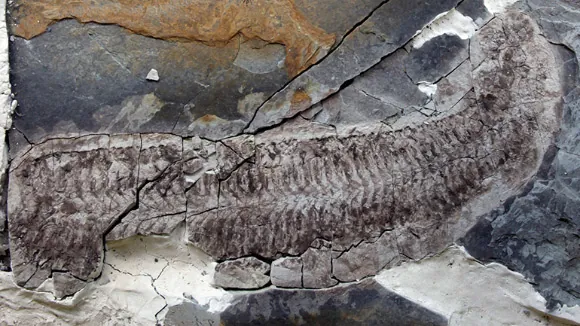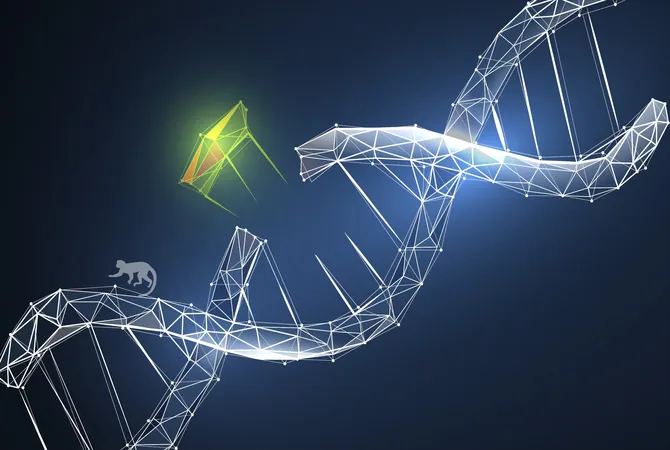
Unveiling the Ancient Mystery: New Species of Ordovician Arthropod Discovered!
2025-03-28
Author: Yu
Groundbreaking Discovery at University of Leicester
A groundbreaking discovery has emerged from the University of Leicester, where a paleontologist has identified a new genus and species of a remarkable multisegmented arthropod. This extraordinary fossil, unearthed in South Africa over two decades ago, has been scientifically designated as *Keurbos susanae*, affectionately nicknamed "Sue" after the discoverer’s mother.
About Sue: The ‘Inside-Out Wonder’
Living approximately 444 million years ago during the Ordovician period, Sue is described as an “inside-out, legless, headless wonder” by Professor Sarah Gabbott, who led the research. What sets this fossil apart from typical specimens is the meticulous preservation of its internal structures, including muscles, sinews, tendons, and even parts of its digestive system – a rare treat for paleontologists who usually examine only the external features of such ancient creatures.
Unique Preservation Circumstances
Interestingly, the fossil's carapace, legs, and head have decayed over time, leaving only the intricate internal details preserved, forming what Professor Gabbott labels a "mineralized time-capsule." This unique preservation raises intriguing questions about Sue's life and environment, especially since it emerged from a time when a major glaciation event caused the extinction of about 85% of Earth’s species, marking one of the five great mass extinction events.
Discovery Location: Soom Shale
The fossil was discovered in the Soom Shale, a site known for its rich historical deposits. "The marine basin where Sue thrived seemed to provide refuge from the catastrophic conditions that decimated life elsewhere," Professor Gabbott explains. "This area was filled with toxic sediments, devoid of oxygen and saturated with deadly hydrogen sulfide, which may have contributed to the extraordinary preservation of the fossil."
Chemical Processes Behind Preservation
The research team believes there is an intriguing chemical process that contributed to Sue's unusual preservation, further complicating her placement in the evolutionary timeline. Despite the wealth of information available about modern arthropods—which comprise 85% of Earth’s animal species, including crustaceans, spiders, and insects—Sue's ancient lineage remains elusive and markedly different due to her unusual preservation.
Concerns Over Future Discoveries
However, a significant concern lies in the potential scarcity of future findings. Professor Gabbott lamented, “The small roadside quarry where I unearthed these fossils is nearly entirely gone, making the chances of discovering additional specimens slim.
Upcoming Publication
The details of this fascinating discovery will be published in an upcoming issue of the journal *Palaeontology*, promising to spark further interest in the evolutionary history of arthropods and their adaptations to past environmental challenges.
Conclusion: Continuing the Search for Prehistoric Life
Scientists continue to delve into the mysteries of our planet's past, one extraordinary fossil at a time, revealing the interconnectedness of life through the ages. Don’t miss the chance to learn more about prehistoric life—stay tuned for more discoveries from the world of paleontology!




 Brasil (PT)
Brasil (PT)
 Canada (EN)
Canada (EN)
 Chile (ES)
Chile (ES)
 Česko (CS)
Česko (CS)
 대한민국 (KO)
대한민국 (KO)
 España (ES)
España (ES)
 France (FR)
France (FR)
 Hong Kong (EN)
Hong Kong (EN)
 Italia (IT)
Italia (IT)
 日本 (JA)
日本 (JA)
 Magyarország (HU)
Magyarország (HU)
 Norge (NO)
Norge (NO)
 Polska (PL)
Polska (PL)
 Schweiz (DE)
Schweiz (DE)
 Singapore (EN)
Singapore (EN)
 Sverige (SV)
Sverige (SV)
 Suomi (FI)
Suomi (FI)
 Türkiye (TR)
Türkiye (TR)
 الإمارات العربية المتحدة (AR)
الإمارات العربية المتحدة (AR)